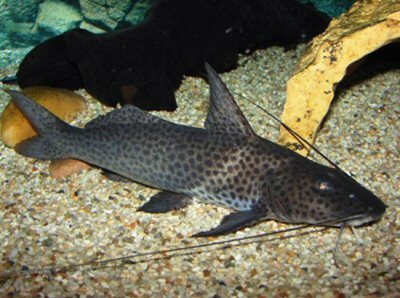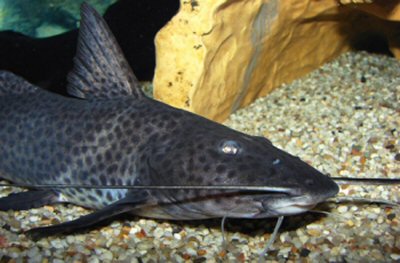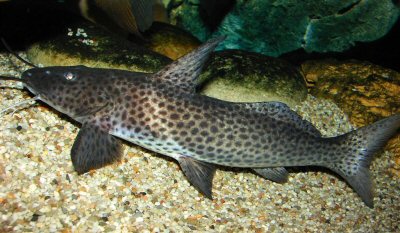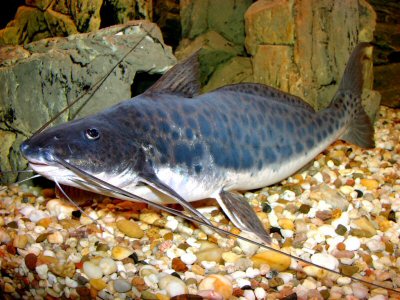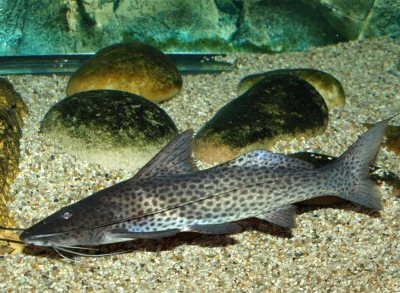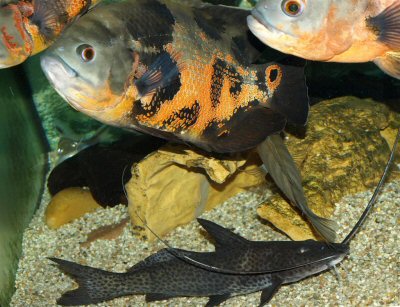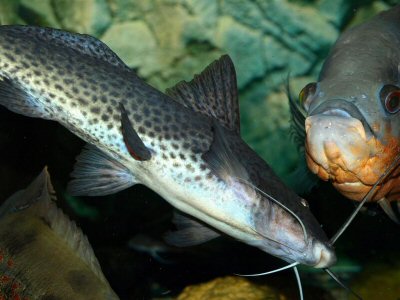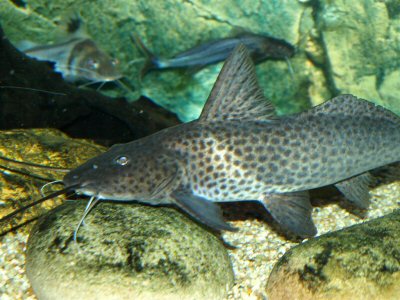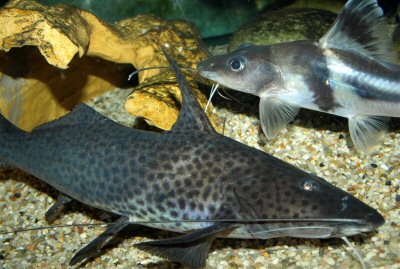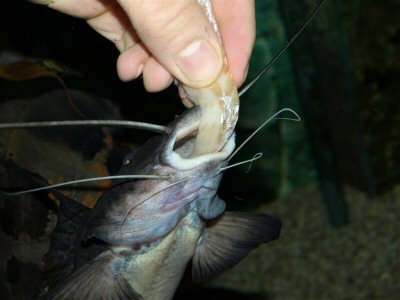SCOTCAT.COM
your internet guide to all things catfish
| Sleek, wiry, and striking: The predator catfish Aguarunichthys torosus |
by Wolfgang Ros |
Aguarunichthys torosus is an agile and fearless fighter/chaser for the “predator aquarium". In particular, the feeding time promises interesting and exciting observations. Other times it usually rests and then gives the observer the idea of a somewhat timid and pretty catfish, but with this species the first impressions can be deceptive! The genus Aguarunichthys belongs to the family of the "Antenna Catfishes" (Pimelodidae) and includes, besides the sporadic imported A. torosus, two other species which are rare even in nature and therefore are not imported very often, A. inpai which at 42 centimeters SL is the biggest species and A. tocantinsensis which at nearly 32 centimeters SL is a bit smaller than A. torosus whose SL in nature is specified at approximately 35 centimeters. Based on a light background all three have a characteristic fine pattern of black dots/points which vary in number and size depending on the species. Particularly striking is a light zone which is a little upstream of the middle of the body and which extends obliquely to the rear in the form of a strip from the back approximately to the beginning of the pectoral and ventral fins. Young specimens of A. torosus are more brightly coloured, but like adults they already show the typical stippling/mottling. The Latin "torosus" stands for muscular and describes the species quite well. Kept in favourable good conditions this catfish seems to stay in good shape and does not seem to have too many grams of fat on its body, and probably why it has gained the German common name of "Stier-Antennenwels" (Bull antenna catfish).
A near adult specimen with almost 35 centimetres in total length resting on its favourite place
A. torosus in profile - his three pairs of highly sensitive barbels allow him excellent orientation
Name: Aguarunichthys torosus (Stewart, 1986); „Aguarun“ = Indian tribe, which lives on both sides of the Peruvian-Ecuadorian border; gr. ichthys = "fish", lat. torosus = "muscular". Distribution:
South America (Rio Cenepa, Peru). Care: A little tricky only in the adaptation period, then keeping is relative unproblematic in preferably large aquariums around 24° C, a powerful filtration, weekly water change, increased current and additional air flow. Does not dig so background planting therefore is possible. Single keeping because of its intraspecies/interspecies territorial behaviour, however can be socialized well with cichlids. Predatory way of living, so do not select other fish species that are too small for sociality. Gender differences and re-production: Unknown. Special features: Extremely agile hunter with a good sense of smell which soon takes the food from the hand of its keeper. Also feeds on earthworms and fish fillets. In form shape and patterning A. torosus reminds us of another, one-third bigger growing catfish of South America, namely Calophysus macropterus, which is comparatively more common in the trade. Unlike the former, A. torosus is spotted nearly to the lower side/bottom of the abdomen, it also lacks almost all of the bluish coloration which is especially characteristic for adult C. macropterus.
A. torosus looks similar to C. macropterus (bottom) which however is more compact and reaches a larger final length
Calophysus macropterus
Aguarunichthys torosus is not one of the fastest growing predatory catfish, although a specimen of 10 cm in length is capable in doubling its body size in about one year, after that however it needs another good two to three years to reach its maximum total length in the aquarium which is usually hardly more than 35 centimeters. Therefore A. torosus, unlike many others bigger growing Pimelodidae, can be kept well by many predatory catfish lovers. Acquisition & Keeping
Conditions With adult specimens you should not keep them in tanks smaller than a two metre length and a minimum depth of 70 centimeters. If the aquarium is too small the danger is greater that the catfish will scare itself, for example with a sudden approximation or handling in the aquarium. It can then start to abruptly dart to the surface and even jump out of the water. The temperature in the tank should be 23 to 26 degrees Celsius and the pH is ideally located between 6 to 7. Weekly partial water change is also recommended. A good tip tip is according to their origin from a river, the species needs a lot of oxygen, so the keeper should provide for a stronger flow and additional ventilation/aeration, then the fish will feel better and visibly demonstrates this in a more active lifestyle. Behavioural
observations Its urge to move around is significantly less than that of the more active C. macropterus. However if you believe, because of the reduced final length of A. torosus compared to C. macropterus, to be able to fall back on a smaller tank you will be soon taught a lesson after introducing this catfish in the aquarium. Though the movements of C. macropterus sometimes can be quite fast, A. torosus once it picks up speed is striking in its motion sequences which is fast paced and like lightening. When fed also during the day, otherwise no later than the onset of darkness, this catfish leaves its place immediately and is actively looking for food. Younger specimens no longer stay in their hiding places and they begin to roam widely in the tank.
This species is not a digger so that planting is possible with robust bigger growing plants. Aguarunichthys torosus is a predatory catfish which likes devouring live food such as earth worms, but it also eats frozen foods such as whole and unbroken smelts, shrimp or mussel meat. After a short familiarization phase it does not disdain from eating fish fillets. Juvenile catfish can be accustomed early to compound and mixed feeds such as tablets or pellets, adult specimens however take them reluctantly. This species will gladly prey on smaller fish. Their hunting behaviour is interesting, which I could observe well after a feeding of a large number of young, only a few centimetres large, Archocentrus nigrofasciatus. Thereby it became clear how very quickly this predator catfish is able to lunge out. Although the young cichlids felt safe in a protected corner specially set up with roots and large stones, my 35 centimetres in total length, nearly adult A. torosus, registered them immediately, as his barbels slightly moving in their direction told. Apparently he was only waiting for a switching off of the aquarium lighting, and indeed, even with the room lights switched on, he preyed on them. Firstly he scared the cichlids by restless searching movements, after which they sought salvation on a wild run. He surprised them by a sudden, rapid lunge, and having had devoured seven cichlids the catfish went to his favourite place near a larger root and stayed motionless all during the night. Skilled food thieves Territorial
behavior At this stage however it can come to conflicts with other bottom oriented predator catfish. A. torosus tries to impress mainly through bumping, so I could not watch injuries caused from that, so usually my specimen, which is socialised with several Pimelodus ornatus and Exallodontus aguanai will strike out blows as fast as lightning. They have become used to his attacks long ago and they normally avoid them. So if you want to socialise A. torosus with other predatory catfish one should fall back on smaller, fast swimming, and especially agile species and provide them with additional retreats if at all possible. One should avoid keeping this species together with larger and territorial species from the Pimelodidae or Pseudopimelodidae, otherwise trouble will be inevitable. In addition the keeper should always be aware of the fact that A. torosus is a predator catfish and for him, too small a fish, and these are basically all which have less than a third of his own body size, especially over night, run the risk of being eaten.
A. torosus knows itself well enough to be able win through in a community tank with cichlids and other predatory catfish
The behavior towards the keeper are clearly different from C. macropterus that even after many years remains a bit cautious. Although initially it lives very withdrawn sometimes even adult specimens lose their shyness and even take food from the hand. The high speed which they show thereby is unusual for predatory catfish. Resting on the ground my specimen has already, after a short time sniffing the scents and the trace smell from the dipped fish-pieces, takes a few lines on the ground restlessly and finally ascends in searching movements. His two longest barbles in these moments literally vibrate and making as good a location as possible, he single mindedly moves to the surface of the water where the fish pieces have been immersed. Swimming by then he pulls and tears larger pieces abruptly, and if necessary with pressure, and forces the chunks out of my fingers which then at once disappear in the surprisingly wide open mouth. Finally the catfish submerges, goes to his favourite place only for a moment and then returns taking the next chunk out of my hand. The following images shows these motions.
Conclusion
This article was published in July 2010 in the German publication: "Die Aquarien und Terrarienzeitschrift" (Datz) 63 (7): 26-29. My thanks apply here to the Datz editorship and their editor-in-chief, Rainer Stawikowski, who gave me kind permission to publish this article on ScotCat.
|
If you would like to contribute an article, please e-mail me. You will of course be credited for your work.
If you would like to donate any denomination of money to the site just click the above link button. All proceeds will go to running the site and hopefully to keep it going for a few years yet.
Print or e-mail this article below
